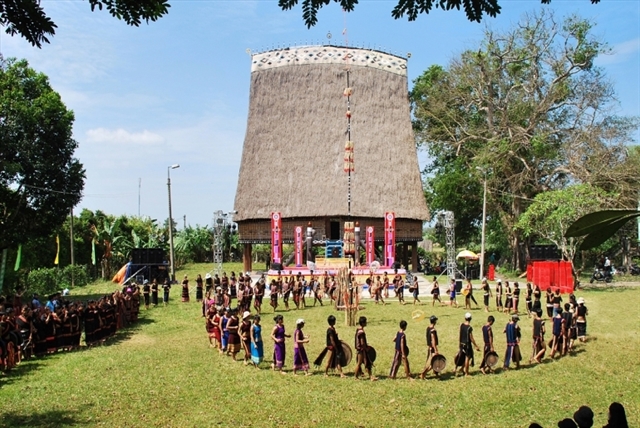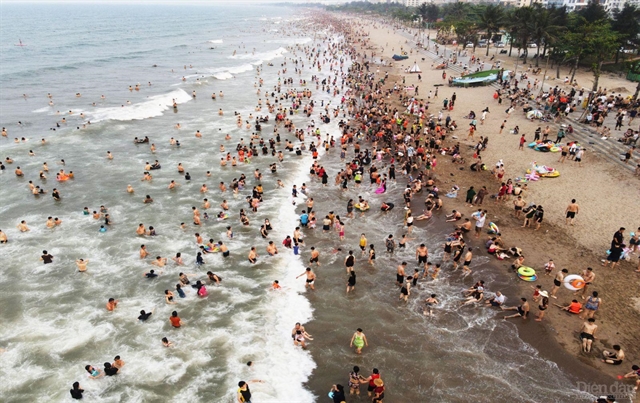 Sunday/Weekend
Sunday/Weekend
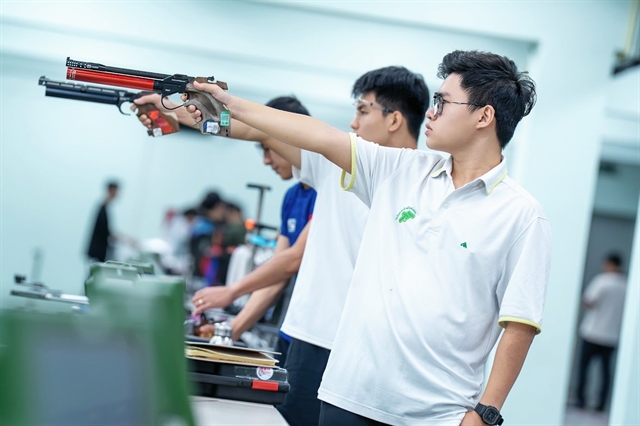
The Mother Goddess religion, considered to be Viet Nam’s oldest religion, is rising in popularity. Each year, tens of thousands flock to the Phủ Dầy festival in Nam Định, a traditional event that is being promoted by the Việt Nam National Commission for UNESCO in hopes of developing spiritual tourism in the country.
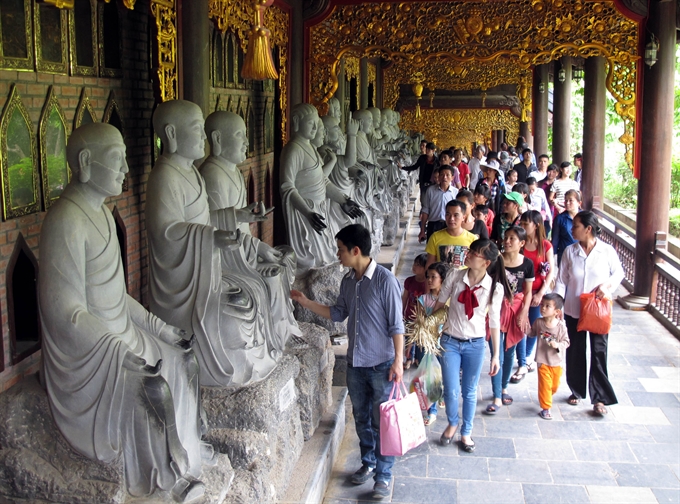 | |
The Mother Goddess religion, considered to be Viet Nam’s oldest religion, is rising in popularity. Each year, tens of thousands flock to the Phủ Dầy festival in Nam Định, a traditional event that is being promoted by the Việt Nam National Commission for UNESCO in hopes of developing spiritual tourism in the country. The recent cold rains of early spring couldn’t make the Phủ Dầy Relic Complex any cooler as hundreds of people, including locals and foreign diplomats in Việt Nam, gathered to watch a hầu đồng performance. As usual, the spiritual trance ritual of the Mother Goddess worship takes place at the temple amidst a very solemn atmosphere. Colourful offerings and flickering candles transform the main sanctuary into a splendid stage, combining with now high and then low music to welcome the spirits. The chosen medium seems to become a different person as he or she gives voice to the deities’ spirits. “Thanks for offering me the opportunity to discover this great and very original ritual. It is an honour for us to come to this sacred place to watch such a solemn yet joyful ritual, where the gods are incarnated in mediums to shower blessings on the followers, said Venezuelan Ambassador Jorge Ronzon Uzcategui about watching a hầu đồng performance for the first time ever at the Phủ Dầy complex in the northern province of Nam Định, after 10 years of serving in Viet Nam. Holding flowers offered by the medium, the ambassador and other diplomats swayed along with the rest of the audience to the joyful melodies of the trance-like singing and dancing. Twenty-two foreign ambassadors, fifty representatives of embassies in Việt Nam, and researchers took part in a two-day cultural and religious tourism tour to discover the three religions of Việt Nam: Đạo mẫu, or Mother Goddess worship, Catholicism, and Buddhism. The tour, organised by the Việt Nam National Commission for UNESCO, began at the Phủ Dầy relic complex, the birthplace of the hầu đồng ritual of the Mother Goddess worship. The Phủ Dầy Complex worships Mother Goddess Liễu Hạnh, one of the Four Immortals of Vietnamese legends. The worship of the Mother Goddesses in Việt Nam is considered the country’s oldest belief, predating even the Chinese occupation here thousands of years ago. In the beginning, goddess worship depicted representations of nature, such as the goddess of the earth, water and mountains. Later, princesses, queens and female founders of craft villages were honoured and worshipped as Mother Goddesses by locals. The image of the Mother Goddess is well recognised in Vietnamese spiritual life. The ritual of worshipping the Mother Goddess also reflects the Vietnamese traditions of patriotism and of remembering the source of the water when it is consumed. Fifty genies, historical figures who rendered great service to the nation, are also worshipped by the Mother Goddess religion. Professor Ngô Đức Thịnh, a leading expert on the Mother Goddess religion in Việt Nam, said the religion was significant because it existed only in Vietnamese tradition. Of the 50 genies, more than 10 were from ethnic minority communities, demonstrating that the Vietnamese people accepted cultural integration even in ancient times. The museum director in Nam Định, Nguyễn Văn Thư, said the province was considered the largest pilgrimage centre for followers of the Mother Goddesses. More than 20 temples and shrines are scattered throughout the Phủ Dầy complex in Vụ Bản District. There are 287 temples, plus vestiges of the belief system, across the province. In recent years, Mother Goddess worship has increased in popularity. The Phủ Dầy festival in Nam Định attracts tens of thousands of followers each year. In 2014, Việt Nam sent documents to UNESCO requesting recognition of Mother Goddess worship as an intangible cultural heritage. The documents are expected to be considered by the UN cultural agency this December. Visibly impressed by the ritual singing and demonstration of Vietnamese culture, Minister Counsellor of Nigeria Bukar Alkali Abdulsalam said he strongly believed the worship should receive the UNESCO distinction. “This belief system has great traditional cultural values that show gratitude to one’s ancestors, predecessors and national heroes,” he said. “There’s also perfect harmony between the costumes, music and dance. I am proud to be here where I can learn more about Vietnamese history.” Catholicism and BuddhismAfter visiting the Phủ Dầy complex, the tour continued to the Phát Diệm cathedral and Bái Đính Pagoda. “We want to promote the culture, history and spiritual beliefs of the Vietnamese people to our international friends,” said Phạm Sanh Châu, secretary general of UNESCO Việt Nam and head of the External Relations Culture Department under the Ministry of Foreign Affairs. “We visit pagodas and spring festivals to pray for happiness. Peace is our tradition on the occasion of the New Year. On that day, we always hope for the best things. We also want our international friends to know that Việt Nam has special values.” Phát Diệm Stone Cathedral in Ninh Binh Province is one of the most famous and beautiful churches in the country featuring special architecture that elegantly combines the style of a Western church with that of Vietnamese worshipping buildings. It was designed by a Vietnamese priest, Father Trần Lực, also called Pere Six in French or cụ Sáu in Vietnamese. It took 24 years to build, between 1875 and 1899. As its name implies, it was built with only stone and wood, which are readily available in the mountains of Ninh Bình. The preparation phase, which mainly involves extracting materials from the limestone mountains, took the locals up to 10 years to finish. The cathedral attracts many visitors, especially during Christmas. Here, visitors can admire the unique architecture and learn more about Catholicism in Việt Nam. Located some 30km from the cathedral, Bái Đính Pagoda is a well-known site at the Tràng An Scenic Landscape Complex, which was recognised as a UNESCO World Heritage Site in 2014. Bái Đính Pagoda is a cluster of Buddhist architectural structures, consisting of new giant, imposing temples in the newly built area that are similar to the ancient, respected shrines in the old area. The pagoda famously holds eight records: the biggest gilt Buddha Shakyamuni statue in Asia (the 100-tonne statue of Shakyamuni Buddha in Pháp Chu Temple); the biggest bronze statue of Buddha in Southeast Asia (the 100-tonne statue of Maitreya Bodhisattva); the country’s largest bronze bell (the 36-tonne bronze bell in the bell tower); the country’s largest pagoda area (539ha); the longest corridor with 500 Arhat statues (two wooden corridors with a total length of 3,400m); the country’s largest number of Arhat statues (500 greenstone Arhat statues); the country’s largest water well (30m in diameter, 6m in depth); and the country’s largest number of Bodhi trees (100 Bodhi trees). Buddhism, the main organised religion of Việt Nam, was first introduced to the country in 111 BC, when the Chinese conquered the Red River Delta. Over the next thousand years, Buddhism fit comfortably into the animist faith of ordinary people and became the dominant popular religion. “I can only say one thing: The trip was unforgettable,” Russian Ambassador Konstantin Vasilievich Vnukov said. “It’s great to see Phát Diệm Cathedral is well preserved and well-respected by locals and tourists. Bái Đính Pagoda and Tràng An Landscape Complex are amazing,” he said. “I will certainly encourage more Russian tourists to come here to witness the cultural and religious richness of Việt Nam. The Russian people are very interested in Vietnamese traditional culture, but so far, they have mostly spent their time on Việt Nam’s seashore.” Encouraging spiritual tourismBased on the positive impressions of the ambassadors and other visitors, the two-day tour to examine three belief systems has proven to be worth including in the spiritual tours offered by travel agencies in the North. Over the last few years, the country’s tourism authorities have considered encouraging spiritual tourism. In 2013, the first International Conference on Spiritual Tourism took place in Bái Đính Pagoda. It attracted nearly 400 participants, half of whom came from overseas. The International Conference on Spiritual Tourism for Sustainable Development explored ways in which living culture, traditions and belief systems could be integrated into tourism while respecting the four pillars of sustainability: the environment, economy, society and culture. The conference was an initiative of World Tourism Organisation Secretary-General Taleb Rifai. Rifai had participated in a study tour to Việt Nam in 2012. The tourism sites in Ninh Bình, particularly Bái Đính Pagoda, a private-invested work, made a positive impression on him. In her opening speech at the conference, Vice President Nguyễn Thị Doan said Việt Nam considered spiritual tourism a kind of cultural tourism and an important factor in strengthening economic growth and boosting patriotism and national unity. Presently, more travel agencies are starting to showcase different tours of pagodas and temples, offering tourists the opportunity to contemplate the beautiful architecture and landscapes and pray for health and happiness. Head of the culture ministry’s National Administration of Tourism Nguyễn Văn Tuấn said spiritual tourism reflected the tangible and intangible cultural heritage religious structures and local customs. He said Việt Nam planned to develop a variety of spiritual tourism packages, such as the triangular Hà Nội-Hạ Long-Ninh Bình tourism route. Another tour will target the Hương (Perfume) Pagoda (Hà Nội), Bái Đính Pagoda and Tràng An tourism site (Ninh Bình) and Trần Temple (Nam Định). He said developing spiritual tourism as part of efforts to develop the country’s tourism industry could also help generate jobs for the locals. — VNS |
 |
| The Phủ Dầy Relic complex in Nam Định Province has attracted an increasing number of Vietnamese people from across the nation who come here to pray for health and happiness. It has become an important site for spiritual tourism. —VNS Photos Truong Vi |
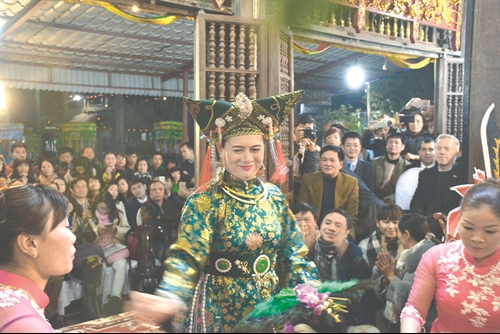 |
| Spiritual ceremony: Foreign diplomats and local inhabitants watch a hau dong performance at the Phủ Dầy Relic Complex in Nam Định province.—VNS Photo Minh Nha |
 |
| Important site: Representatives of different embassies in Viet Nam listen to stories about the history of the Phát Diệm Stone Cathedral in Ninh Bình Province. —VNS Photo Bạch Liên |


